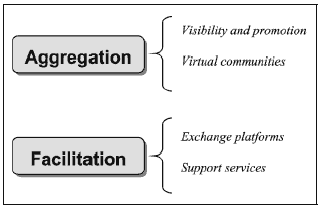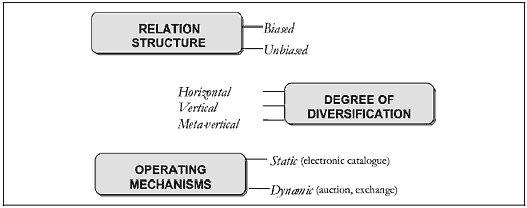The basic role of infomediaries is to act as aggregator and facilitator (see Figure 2).

Figure 2 Service Functions in B2B Markets
In this sense, they provide electronic storefronts that permit firms to promote their online activities, obtain high visibility, and build virtual communities where companies can have access to news, analysis, buyers and sellers’ guides and interactive resources.
As facilitators, infomediaries provide software, tools and services enabling traders to run business electronically.
In this case, they provide exchange platforms (such as electronic catalogues, RFQs and RFPs, bids and auctions) that can digitally carry out the transactions.
In addition, they also provide logistics and financial services to manage the transaction processes.
The development of b2b markets is giving rise to a wide variety of business models, which combine the aggregation and original ways.
As we see in Figure 3, b2b infomediaries may be classified according to three dimensions: the relation structure, the degree of diversification, and the transaction operating mechanisms.
Based on the relational attitude, the infomediary can be biased or unbiased.
If he is unbiased, the third party providing services is equidistant from the market participants; if he is biased, the intermediary acts in the interest of one of the two counterparts.

Figure 3 A Model of Classification of B2B Intermediaries
On the contrary, Chemdex.com and Ingrammicro.com are two biased operators: the former aggregates the demand in the chemicals industry whereas the latter aggregates the offers in the PC industry.
Market fragmentation profoundly influences the choice between these two models.
When it is bilateral, a neutral operator is probably the best way to improve transaction efficiency.
However, if the market is fragmented only on one side, digital services often take the form of an asymmetrical infomediation. According to the diversification, infomediaries can be horizontal, vertical and meta-vertical.
The differences lie in the number and characteristics of the users reached.
Horizontal hubs normally address inefficiencies common to multiple supply chains.
They normally focus on a process or service, or involve the trade of indirect inputs (goods and services used in peripheral maintenance, repair and operation, such as machines, computers, and maintenance activities).
Companies from all industries can potentially benefit from this kind of offer.
IMark.com, in the e-recruiting industry, Advexpress.it, in the advertising business and Machinetools.com, in the equipment industry, are examples of these types of infomediaries.
For these hubs, the service delivered is closely connected to the digital platform and covers many phases of the procurement process.
Vertical marketplaces usually trade direct inputs (products and services directly incorporated in the production process) and focus on inefficiencies that exist across a supply chain in a specific industry.
Examples of vertical European marketplaces are Allplastx.com, in the plastics sector, Steelscreen.com in the metal industry and Marbleandmore.com in the marble industry.
In these trading models the digital platform is often enhanced by additional services in order to match industry-specific needs.
Meta-vertical portals aggregate various vertical marketplaces in one site, by taking advantage of different sets of services that can be concentrated and delivered to companies from different sectors.
Marketplaceitaly. com is a b2b trading portal which targets SMEs. Verticalnet.com leverages its well-established digital brand to differentiate and offer the same trading platform to many vertical markets.
Finally, an important distinction should be made with regard to operating mechanisms.
The catalogue trading model electronically aggregates, standardises and indexes different catalogues or buyer requests.
Transactions take place after the customer has navigated the system and chosen the best offer among those given.
In this operating model, prices are fixed and negotiated in advance, and it is impossible to make the exchange more dynamic.
Fob.com is an example of aggregation in the chemicals industry.
The auction is a dynamic system with a one-to-many trading model: a counterpart posts a selling (auction) or buying (reverse auction) request on the marketplace and defines the expiry term of the transaction.
The main feature of this mechanism is a price adjustment process in a time-scheduled transaction scheme.
ESteel.com provides a b2b auction platform in the steel industry.
A different version of dynamic price mechanisms occurs in the exchange model.
In this system, the transaction occurs in real time according to a manyto- many scheme in which the counterpart often remains anonymous.
In this model, buyers and sellers compete simultaneously for exchanges, with no time restriction.
Actors are allowed to participate repeatedly like buyers or sellers since the products are commodities.
For example, Altraenergy.com offers this kind of service in the energy industry and Arbinet.com in telecommunications.
Since these infomediation services can be widely applied, it is possible to redesign the structure of the value chain.
The search for competitive advantage is behind this change.